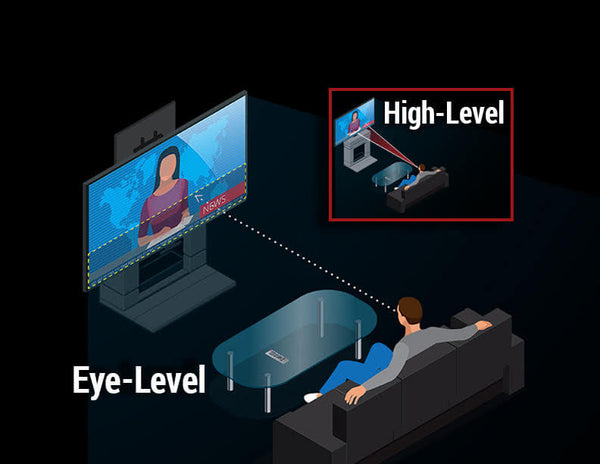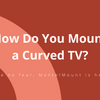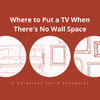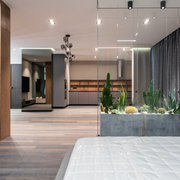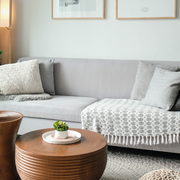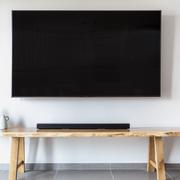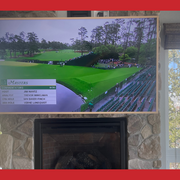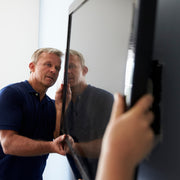Why You Should Place The Bottom Third of Your TV Screen Below Eye-Level

Placing your tv at the wrong angle or too high on the wall can have greater consequences than a skewed picture; it can cause eye strain and even neck pain! If you’re a tv aficionado looking to achieve manufacturer-level clarity and color quality, check out these tips for finding the perfect angle, height, and lighting settings for your tv.
Can lighting affect the tv-viewing experience?
Lighting can, indeed, affect your tv viewing. Whether that’s due to poor lighting around your tv or a setting on your tv, lighting is one of the key components to creating the perfect viewing angle tv experience.
For the television screen light, ensure that the brightness is turned down enough so you’re still able to clearly see the picture, but doing so won’t strain your eyes. Whether your furniture is positioned at the best angle for watching tv or not, having the tv screen light emit a more palatable glow will help ease eye strain.
In addition to your tv’s settings, achieving the right atmospheric lighting can also be challenging, especially if you’re watching tv in an unconventional place like a patio or covered porch. Most experts recommend facing your tv north so southern exposure is always behind your tv screen. But if that’s not an option in your living, just make sure your tv isn’t in direct sunlight.
Additionally, you can add bias lighting to the back of your tv. What is it, you ask? Bias lighting is a weak light source placed behind a screen or a projector to reduce perceived brightness. Incorporating bias lighting helps lessen eye fatigue because it offsets the brightness of the main light source, in the case the tv, and allows the eyes to focus more comfortably.
If bias lighting is chosen as part of a way to strengthen the viewers enjoyment in tv watching, consider a bulb that is around 6,500K. Another factor that puts a strain on the eyes, besides the lighting (or lack thereof!) in the tv’s room, is the viewing angle.
Why is it best to place your tv at eye-level?
As someone who has watched movies and tv before, you can probably list a dozen reasons why placing a screen at eye-level creates the best viewing experience. But did you know that proper tv height is actually a manufacturing recommendation, too?
For the highest quality tv picture, manufacturers suggest that the bottom third of your screen should sit below your eye-level. This is because when a tv screen sits too high above the eyeline this results in a 20% reduction in color depth and brightness, and a 200% reduction in contrast, making it much harder to see details on the screen.
This is one of the most common issues when mounting a tv from a high position like above a mantel. Even when viewed from a standard distance, the typical height above a fireplace will be well above the manufacturer-suggested viewing height. By pulling your tv down towards eye-level with MantelMount, you’re assured a much finer picture color and clarity, as well as your greatest level of enjoyment.
So, what is the best tv-viewing angle?
Once you’ve discovered the perfect lighting, consider the best angle for watching tv. The audio and visual entertainment company THX has stated that for the best tv viewing angle for watching a show, movie, or game, the viewer’s line of sight should be the center of the screen. If that’s not possible, for instance you’ve mounted your tv above a console table, they suggest a gradient above or below the center of the television at 15 degrees (or less).
While this suggestion comes from a highlight authoritative source, think about the last time you went to the movie theater a say slightly too close to the screen so you have to crane your neck back and look up to properly see. It can get exhausting and painful to hold your neck in that position for the duration of a film or a good Netflix binge. So we recommend being a little conservative with this 15 degree suggestion and opt for as close to placing the center of your screen at eye-level as possible—after all, we’re tv-viewing experts too!
Not only are your eyes working overtime if the lighting on the tv is poor and the lighting in the room is poor, your eyes will strain with an unfavorable viewing angle due to the picture quality, including the clarity of the light emissions emanating from the tv itself. For a comparison of plasma versus led versus OLED and QLED televisions when it comes to the richness and quality of the picture, take a look at our blog for more insight.
Using a tv mount to achieve the perfect viewing angle
Although 15 degrees is the rule-of-thumb for stationary televisions, a wall mount tv angle can give you some leeway in terms of how high you place the center of your tv screen. Because tv wall mounts, like MantelMount’s MM540 Enhanced or MM700 Premier, allow for vertical and swivel adjustments, no matter if you’re sitting or standing, you can get a perfect height and angle every time.
Even though you can achieve a variety of wall mount tv angles with a pull down mount, you can also manipulate the perfect tv-viewing angle with proper furniture placement. For wall-mounted televisions or for those on a media console or other viewing platform, there is a common ratio used for the distance placed in between the couch or seating area and the tv.
Once you’ve achieved the perfect lighting and you’ve positioned your tv at just the right angle, you’re ready to kick back and enjoy your favorite shows and movies—uninterrupted by neck pain or tv glare.
